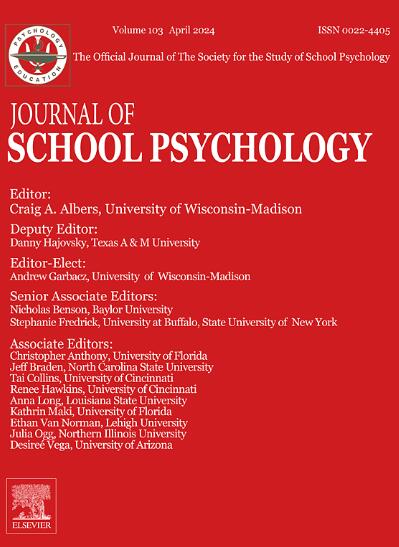Context matters: Diagnosing and targeting local barriers to success at school
IF 4.1
1区 心理学
Q1 PSYCHOLOGY, SOCIAL
引用次数: 0
Abstract
We trialed a novel method aimed at reducing educational inequalities in any given school by tailoring an intervention to address the specific local social, cultural, and psychological barriers that contribute to those inequalities. In Study 1 (N = 2070), we validated measures in a student survey of barriers experienced by students ages 11–16 years in two schools in England. We used a pilot version of these measures to identify two barriers that appeared to be contributing in both schools to poorer attendance and behavioral records of Black versus Asian students and of lower socioeconomic status (SES) students versus higher SES students. These barriers consisted of perceptions that (a) the schools were biased against certain groups of students and that there were negative stereotypes about certain groups of students, and (b) teachers and students did not come from similar backgrounds. In Study 2, which was pre-registered, we administered a brief tailored intervention to target these barriers in students ages 11–14 years in the same two schools the following year (N = 1070). The intervention, which aimed to induce values affirmation and reveal hidden teacher-student similarities, improved the attendance of low-SES students by 0.20 SD (p = .009) and reduced the gap with their peers by 60%. Exploratory analyses indicated that the improvement in attendance was larger for students who reported perceiving greater levels of bias and poorer teacher-student relationships at baseline. The impact of the intervention on the behavioral records of Black students (p = .089) and low-SES students (p = .293) was not significant. These qualified but encouraging findings provide a basis for developing practical ways for individual schools to improve outcomes for their historically disadvantaged students.
背景很重要:诊断和针对阻碍在学校取得成功的当地障碍
我们尝试了一种新的方法,旨在通过定制干预措施来解决导致这些不平等的特定当地社会、文化和心理障碍,从而减少任何一所学校的教育不平等。在研究1 (N = 2070)中,我们对英国两所学校11-16岁学生所经历的障碍的学生调查进行了验证。我们使用这些措施的试点版本来确定两所学校的两个障碍,这些障碍似乎导致黑人学生与亚洲学生以及社会经济地位较低的学生与社会经济地位较高的学生的出勤率和行为记录较差。这些障碍包括:(a)学校对某些学生群体有偏见,对某些学生群体有负面的刻板印象,以及(b)教师和学生的背景不同。在预登记的研究2中,我们在第二年对同样两所学校11-14岁的学生进行了简短的量身定制的干预,以针对这些障碍(N = 1070)。旨在诱导价值观肯定和揭示隐藏的师生相似性的干预,使低社会经济地位学生的出勤率提高了0.20 SD (p = 0.009),与同龄人的差距缩小了60%。探索性分析表明,在基线上,那些报告认为偏见程度较高、师生关系较差的学生,出勤率的提高更大。干预对黑人学生(p = 0.089)和低经济地位学生(p = 0.293)行为记录的影响不显著。这些合格但令人鼓舞的发现为个别学校开发切实可行的方法提供了基础,以改善其历史上处于不利地位的学生的成绩。
本文章由计算机程序翻译,如有差异,请以英文原文为准。
求助全文
约1分钟内获得全文
求助全文
来源期刊

Journal of School Psychology
PSYCHOLOGY, EDUCATIONAL-
CiteScore
6.70
自引率
8.00%
发文量
71
期刊介绍:
The Journal of School Psychology publishes original empirical articles and critical reviews of the literature on research and practices relevant to psychological and behavioral processes in school settings. JSP presents research on intervention mechanisms and approaches; schooling effects on the development of social, cognitive, mental-health, and achievement-related outcomes; assessment; and consultation. Submissions from a variety of disciplines are encouraged. All manuscripts are read by the Editor and one or more editorial consultants with the intent of providing appropriate and constructive written reviews.
 求助内容:
求助内容: 应助结果提醒方式:
应助结果提醒方式:


